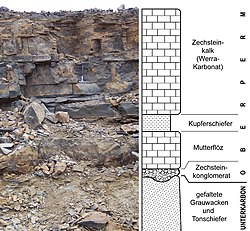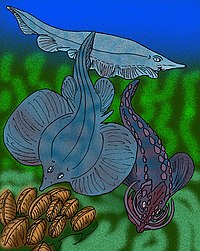Wuchiapingian
| Wuchiapingian | |||||||||||||
|---|---|---|---|---|---|---|---|---|---|---|---|---|---|
 Wuchiapingian aged stratigraphic succession including the Kupferschiefer, Kamsdorf mine near Saalfeld, Thuringia, Germany | |||||||||||||
| Chronology | |||||||||||||
| |||||||||||||
| Etymology | |||||||||||||
| Name formality | Formal | ||||||||||||
| Usage information | |||||||||||||
| Celestial body | Earth | ||||||||||||
| Regional usage | Global (ICS) | ||||||||||||
| Time scale(s) used | ICS Time Scale | ||||||||||||
| Definition | |||||||||||||
| Chronological unit | Age | ||||||||||||
| Stratigraphic unit | Stage | ||||||||||||
| Time span formality | Formal | ||||||||||||
| Lower boundary definition | FAD of the Conodont Clarkina postbitteri postbitteri | ||||||||||||
| Lower boundary GSSP | , Laibin, Guangxi, China 23°41′43″N 109°19′16″E / 23.6953°N 109.3211°E | ||||||||||||
| GSSP ratified | 2004[2] | ||||||||||||
| Upper boundary definition | Meishan, Zhejiang, China | ||||||||||||
| Upper boundary GSSP | FAD of the Conodont Clarkina wangi 31°04′55″N 119°42′23″E / 31.0819°N 119.7064°E | ||||||||||||
| GSSP ratified | 2005[3] | ||||||||||||
In the geologic timescale, the Wuchiapingian or Wujiapingian (from Chinese: 吴家坪; pinyin: Wújiāpíng; lit. 'Wu Family Flatland"' in the Liangshan area of Hanzhong, Shaanxi Province[4]) is an age or stage of the Permian. It is also the lower or earlier of two subdivisions of the Lopingian Epoch or Series. The Wuchiapingian spans the time between 259.1 and 254.14 million years ago (Ma). It was preceded by the Capitanian and followed by the Changhsingian.[5]
Regional stages with which the Wuchiapingian is coeval or overlaps include the Djulfian or Dzhulfian, Longtanian, Rustlerian, Saladoan, and Castilian.[6]
Stratigraphic definitions[]
The Wuchiapingian was first used in 1962, when the Lopingian Series of southwestern China was divided in the Changhsingian and Wuchiapingian Formations. In 1973 the Wuchiapingian was first used as a chronostratigraphic unit (i.e. a stage, as opposed to a formation, which is a lithostratigraphic unit).[7]
The base of the Wuchiapingian Stage is defined as the place in the stratigraphic record where the conodont species Clarkina postbitteri postbitteri first appears. A global reference profile for this boundary (a GSSP) is located near Laibin in the Chinese province of Guangxi.[8]
The top of the Wuchiapingian (the base of the Changhsingian) is at the first appearance of conodont species Clarkina wangi.
The Wuchiapingian contains two ammonite biozones: that of the genus Araxoceras and that of the genera and Doulingoceras.
Biodiversity[]
An extinction pulse occurred during the Wuchiapingian; faunas were recovering when another larger extinction pulse, the Permian–Triassic extinction event devastated life.[9]
Wuchiapingian life[]
Chondrichthyans[]
| Chondrichthyes of the Wuchiapingian | ||||
|---|---|---|---|---|
| Taxa | Presence | Location | Description | Images |
|
|
Lopingian | Greenland | a eugeneodontid holocephalian | |
| Carboniferous to Early Triassic | Greenland | a eugeneodontid holocephalian | ||
| Lopingian | Germany | a neoselachian elasmobranch | ||
| Carboniferous to Lopingian | Germany, Pakistan, Greenland, United States | a petalodontiform holocephalian | ||
| Lopingian | Germany | a holocephalian | ||
| Lopingian | Greenland | a eugeneodontid holocephalian | ||
| Lopingian | Germany | |||
Actinopterygians[]
| Actinopterygii of the Wuchiapingian | ||||
|---|---|---|---|---|
| Taxa | Presence | Location | Description | Images |
| Lopingian | Germany, England | A neopterygian, possibly a semionotiform | ||
| Carboniferous to Lopingian | Germany, England | A non-neopterygian | ||
| Lopingian | Greenland | A non-neopterygian | ||
| Lopingian | Germany, England | A bobasatraniiform non-neopterygian | ||
| Lopingian | Germany, England | A palaeonsicid non-neopterygian. One of the most common ray-fins of the late Permian | ||
| Carboniferous to Lopingian | Germany, England | A non-neopterygian | ||
|
|
Lopingian to Middle Triassic | Germany | A non-neopterygian | |
|
|
Permian | Russia | A non-neopterygian | |
Coelacanths[]
| Actinistia of the Wuchiapingian | ||||
|---|---|---|---|---|
| Taxa | Presence | Location | Description | Images |
| Permian | Germany, England | The first described coelacanth |
 Coelacanthus (foreground) | |
†Temnospondyls[]
| Temnospondyli of the Wuchiapingian | ||||
|---|---|---|---|---|
| Taxa | Presence | Location | Description | Images |
| Lopingian | Russia | A dvinosaurian temnospondyl amphibian. | ||
| , Russia | A basal temnospondyl amphibian, possibly an archegosauroid. | |||
| Beaufort Group, South Africa | A genus of stereospondyl amphibian in the family Rhinesuchidae. | |||
| Tanzania, Africa | A large armoured basal stereospondyl amphibian. | |||
| Malawi, Africa | A genus of stereospondyl amphibian in the family Rhinesuchidae. | |||
|
Karoo Supergroup, South Africa | A species of stereospondyl amphibian in the family Rhinesuchidae. | ||
†Chroniosuchians[]
| Chroniosuchia of the Wuchiapingian | ||||
|---|---|---|---|---|
| Taxa | Presence | Location | Description | Images |
| Guadalupian to Lopingian | Russia | A reptiliomorph | ||
|
Shangshihezi Formation, Henan, China | A species of bystrowianid reptiliomorph. | ||
| Lopingian | Russia | A reptiliomorph | ||
†Seymouriamorphs[]
| Seymouriamorpha of the Wuchiapingian | ||||
|---|---|---|---|---|
| Taxa | Presence | Location | Description | Images |
| Lopingian | Russia | A seymouriamorph reptiliomorph | ||
| Russia | A seymouriamorph reptiliomorph | |||
†Procolophonomorphs[]
| Procolophonomorpha of the Wuchiapingian | ||||
|---|---|---|---|---|
| Taxa | Presence | Location | Description | Images |
| Lopingian | Morocco | A pareiasaurid parareptile | ||
| Lopingian | Russia | A nycteroleterid parareptile | ||
| Lopingian to Early Triassic | South Africa | An owenettid parareptile | ||
| Lopingian | Kupferschiefer, Germany | A dubious pareiasaurid parareptile | ||
| Lopingian | South Africa | A pareiasaurid parareptile | ||
| Lopingian to Early Triassic | South Africa, Brazil, Antarctica | A procolophonid parareptile | ||
| Lopingian | Russia | A procolophonid parareptile | ||
Eureptiles[]
| Eureptilia of the Wuchiapingian | ||||
|---|---|---|---|---|
| Taxa | Presence | Location | Description | Images |
| Lopingian | South Africa | A late surviving, yet rather basal, captorhinid reptile | ||
Diapsids[]
| Diapsida of the Wuchiapingian | ||||
|---|---|---|---|---|
| Taxa | Presence | Location | Description | Images |
| Lopingian | Madagascar, Germany, England | A gliding weigeltisaurid reptile | ||
|
Kupferschiefer sediments, Germany | A gliding weigeltisaurid reptile. | ||
| Germany and England | A gliding weigeltisaurid reptile. | |||
Archosauromorphs[]
| Archosauromorpha of the Wuchiapingian | ||||
|---|---|---|---|---|
| Taxa | Presence | Location | Description | Images |
| Usili Formation, Songea District, southern Tanzania | An early archosauromorph, possibly the most basal one known. | |||
| Late Capitanian? - Wuchiapingian | Russia | An archosauromorph reptile | ||
| Lopingian | England, Germany | An early basal archosauromorph reptile | ||
Synapsids[]
Therapsids[]
| Therapsida of the Wuchiapingian | ||||
|---|---|---|---|---|
| Taxa | Presence | Location | Description | Images |
| Lopingian | Karoo Basin, South Africa | A charassognathid cynodont | ||
| Lopingian | Karoo Basin, South Africa and Zambia | A gorgonopsian therapsid | ||
| Lopingian, Tropidostoma Assemblage Zone, Teekloof Formation | Karoo Basin, South Africa | A charassognathid cynodont | ||
| Lopingian, Cistecephalus Assemblage Zone; Tropidostoma Assemblage Zone | Karoo Basin, South Africa and Zambia | A dicynodont therapsid | ||
| Lopingian, Cistecephalus Assemblage Zone | Karoo Basin, South Africa and Zambia | A gorgonopsian therapsid | ||
| Lopingian | South Africa | A basal dicynodont therapsid | ||
| Lopingian | South Africa | A dicynodont therapsid | ||
| Lopingian | Zambia, South Africa | A dicynodont therapsid | ||
| Lopingian | South Africa | A dicynodont therapsid | ||
| Lopingian | Brazil, India, South Africa | A dicynodont therapsid | ||
| Lopingian | Mildenhalls, Fort Beaufort; Karoo Basin, Beaufort West, both in South Africa, possibly , Malawi | A gorgonopsian therapsid | ||
| Lopingian | South Africa | A biarmosuchian therapsid | ||
| Lopingian | South Africa | A biarmosuchian therapsid | ||
| Guadalupian to Lopingian | South Africa | A gorgonopsian therapsid | ||
| Lopingian | , Zambia | A charassognathid cynodont | ||
| Lopingian | South Africa, Tanzania | A gorgonopsian therapsid | ||
| Lopingian | Usili Formation, Tanzania | A gorgonopsian therapsid | ||
| Lopingian | Usili Formation, Tanzania | A gorgonopsian therapsid | ||
| Lopingian | South Africa | A dicynodont therapsid | ||
References[]
- ^ "Chart/Time Scale". www.stratigraphy.org. International Commission on Stratigraphy.
- ^ Jin, Yugan; Shen, Shuzhong; Henderson, Charles; Wang, Xiangdong; Wang, Wei; Wang, Yue; Cao, Changqun; Shang, Qinghua (December 2006). "The Global Stratotype Section and Point (GSSP) for the boundary between the Capitanian and Wuchiapingian Stage (Permian)" (PDF). Episodes. 29: 253–262. Retrieved 13 December 2020.
- ^ Jin, Yugan; Wang, Yue; Henderson, Charles; Wardlaw, Bruce; Shen, Shuzhong; Cao, Changqun (September 2006). "The Global Boundary Stratotype Section and Point (GSSP) for the base of Changhsingian Stage (Upper Permian)". Episodes. 29 (3): 175–182. doi:10.18814/epiiugs/2006/v29i3/003. Retrieved 23 December 2020.
- ^ "陕西汉中梁山吴家坪灰岩的再研究 (Restudies on the Wujiaping Limestone Liangshan of Hanzhong, Shaanxi)". Retrieved 29 November 2012.
- ^ Gradstein, F. M.; Ogg, J. G. & Smith, A. G.; 2004: A Geologic Time Scale 2004, Cambridge University Press
- ^ "Wuchiapingian". GeoWhen Database, International Commission on Stratigraphy (ICS). Retrieved 4 March 2010.
- ^ Kanmera, Kametoshi; and Nakazawa, Keiji, 1973, Permian-Triassic relationships and faunal changes in the eastern Tethys, in Logan, A.; and Hills, L. V.; eds.; The Permian and Triassic Systems and their mutual boundary, Canadian Society of Petroleum Geologists, Memoir 2, pp. 100–129
- ^ Jin, Y.; Shen, S.; Henderson, C. M.; Wang, X.; Wang, W.; Wang, Y.; Cao, C. & Shang, Q.; 2006: The Global Stratotype Section and Point (GSSP) for the boundary between the Capitanian and Wuchiapingian Stage (Permian), Episodes 29(4), pp. 253–262
- ^ Sahney, S. & Benton, M.J. (2008). "Recovery from the most profound mass extinction of all time". Proceedings of the Royal Society B: Biological Sciences. 275 (1636): 759–65. doi:10.1098/rspb.2007.1370. PMC 2596898. PMID 18198148.
External links[]
- GeoWhen Database - Wuchiapingian
- Upper Paleozoic stratigraphic chart at the website of the subcommission for stratigraphic information of the ICS
Coordinates: 23°41′43″N 109°19′16″E / 23.6953°N 109.3211°E
- Wuchiapingian
- Permian geochronology
- Permian China
- Lopingian
- Hanzhong
- Paleontology in Shaanxi
- Permian Asia

































